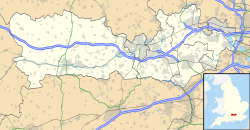| Combe | |
|---|---|
| Village and civil parish | |
 Thatched cottage in Combe | |
Location within Berkshire | |
| Population | 38 (2001) |
| OS grid reference | SU370608 |
| Civil parish |
|
| Unitary authority | |
| Ceremonial county | |
| Region | |
| Country | England |
| Sovereign state | United Kingdom |
| Post town | HUNGERFORD |
| Postcode district | RG17 |
| Dialling code | 01488 |
| Police | Thames Valley |
| Fire | Royal Berkshire |
| Ambulance | South Central |
| UK Parliament | |
Combe is a village and civil parish in the English county of Berkshire. The parish is situated on the top of the North Hampshire Downs near Walbury Hill and Combe Gibbet, overlooking the village of Inkpen and the valley of the River Kennet. In Walbury Hill, it includes the highest natural point in South East England. [1] [2] [3]
Contents
Administratively, the civil parish lies within the unitary authority area of West Berkshire, and within the ceremonial county of Berkshire. Historically part of Hampshire, Combe was transferred to Berkshire in 1895. [1] [2]

